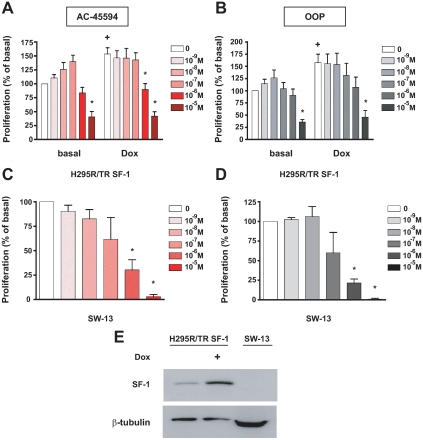Figure 1.
Inhibition of human adrenocortical cell proliferation by alkyloxyphenols. A and B, H295R TR/SF-1 cells were treated with increasing doses of the AC-45594 (A) and OOP (B) compounds (at doses ranging from 10−9 to 10−5 m) in duplicate wells in the absence or presence of Dox (1 μg/ml). Data are expressed as the percentage of increment or reduction over the number of cells cultured in the presence of DMSO vehicle for 4 d (mean ± sem of four experiments). The difference in cell numbers between H295R TR/SF-1 cells cultured in the absence or presence of Dox is statistically significant (+; P < 0.01, t test). *, Values significantly different from DMSO control (P < 0.01, two way-ANOVA with Bonferroni posttest). C and D, Effect of AC-45594 (C) and OOP (D) compounds (doses ranging from 10−9 to 10−5 m) on proliferation of SW-13 cells. Data are expressed as the percentage of increment or reduction over the number of cells cultured in the presence of DMSO vehicle for 4 d (mean ± sem of four experiments). *, Values significantly different from DMSO control (P < 0.01, one way-ANOVA with Bonferroni posttest). E, Immunoblot showing increased expression of SF-1 after Dox treatment of H295R/TR SF-1 cells and lack of detectable SF-1 expression in SW-13 cells. With the purpose of increasing the sensitivity of the assay, SW-13 extracts were overloaded compared with H295R/TR SF-1 extracts, as shown by β-tubulin expression.

